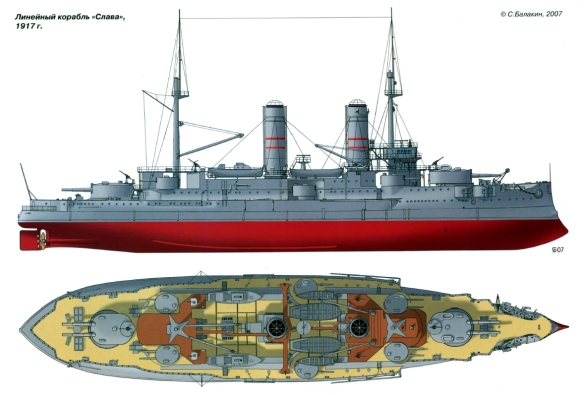Borodino-class
OPERATING THE GUN
The turret commander received estimated range-to-target data from the gunnery officer on the bridge by means of the system of electrical dials underneath the turret. If the gunnery officer turned his dial to “5,000 yards,” the turret commander would see his dial move to that value as well. The lay and azimuth of the main battery was then adjusted by either electrical or hand controls. Powder charges and shells were brought up by the electrical hoists from below, laid in the shell tray and then rammed in. Russian gun loading procedures were generally 30-60 seconds slower than the Japanese, but given the limited amount of main gun ammunition carried aboard, this hardly mattered in an extended engagement. The guns were then fired by a lanyard an Russian ships, or an electrical switch on Japanese ships.
#
By early 1898, the Russian shipyards around St Petersburg had six battleships under construction but since average build time was over five years, the Naval Ministry turned to foreign yards to reach its goal of ten battleships for the Far East. The American shipbuilder Charles Henry Cramp, eager to gain a contract for both new battleships, travelled to St Petersburg and with the help of the US ambassador he peddled a design based on the American battleship Iowa. Cramp had already built four battleships for the US Navy and after some hesitation the MTK accepted a modified proposal. The contract signed in April 1898 required Cramp to build a 12,700-ton battleship in 30 months at a price of $4.36 million (£1.09 million). Construction began on the Retvizan in December 1898 at the Cramp yard in Philadelphia. The Retvizan was built with a flush-deck hull and used French-designed 12-in gun turrets, but kept the secondary armament in armoured casemates. Both the turrets and the main armament were built in Russia and shipped to Philadelphia for installation. Cramp favoured the new French-designed Niclausse high-pressure water tube boilers – which he claimed offered improved performance and reliability over the Belleville boiler – so the MTK reluctantly agreed to try this novel steam plant on the Retvizan. Bethlehem Iron Works supplied Krupp-style armour plate_ Despite Cramp’s claims, he failed to complete the Retvizan on time and its Niclausse boilers proved unable to deliver the 18-knot speed promised. Furthermore, the Niclausse boilers proved to be dangerous and unreliable. On the plus side, the Retvizan was only slightly overweight so its main belt armour was not compromised and its armament proved satisfactory in gunnery trials.
Another foreigner eager to hawk his designs to the Russian Naval Ministry was Antoine-Jean Amable Lagane, director of the French shipyard Forges et Chantiers de la Mediterranee in La Seyne (Toulon). He presented the MTK with a design for a battleship based on the French Jaureguiberry. Lagane was aided by the support of the Francophile Grand Duke Aleksei Aleksandrovich, brother of Tsar Aleksandr III and nominally head of the Imperial Navy. In July 1898 the Naval Ministry signed a contract with Lagane to build a 12,900-ton battleship in 42 months at a cost of 30.28 million francs (£1.47 million). Construction began on the Tsesarevich in May 1899 but like Cramp, Lagane failed to meet the schedule and the ship required 51 months to complete. The Tsesarevich had a high-forecastle hull with a curved tumblehome shape – the beam of the ship narrowed from the waterline to the upper deck, in order to reduce the weight of the upper deck – which French designers believed would allow greater freeboard and improved seaworthiness. The Tsesarevich also incorporated a 9.8-in-thick main belt of Krupp armour using Louis-Emile Bertin’s “cellular” approach to protection, which enhanced the ship’s ability to survive damage and remain afloat. The Belleville boilers that the MTK had insisted on proved far more reliable than Cramp’s Niclausse boilers and in trials the Tsesarevich achieved speeds at over 18 knots. In virtually every respect, the Tsesarevich was the best Russian battleship built prior to the Russo-Japanese War.
The Russian Naval Technical Committee (MTK) and Grand Duke Aleksandrovich were very impressed with the design and wanted to build a similar type of battleship in the yards of St Petersburg. Even before the contract with Lagane was signed, the MTK directed Dmitri V. Skvortsov, a designer for the New Admiralty yard, to take the sketches from Lagane’s technical proposals and turn them into a Russian version. Skvortsov had to increase the designed displacement by 600 tons over the Tsesarevich since Russian built turrets and engine-room equipment were heavier than the French-built versions, but in three weeks he produced plans for the new Borodino-class battleships. After eight months of dithering, on March 23, 1899 the MTK finally chose a modified Skvortsov design and placed an order for three new battleships: the Borodino from the New Admiralty yard, the Imperator Aleksandr III from the Baltic Works and the Orel from the Galerniy yard. Construction work began on the first two in July 1899 and the third in March 1900. Two more ships of the class, Kniaz Suvarov and Slava, were ordered in 1900. Although the Borodino-class was outwardly similar to the Tsesarevich, the increase in their displacement had a major impact on their combat-effectiveness.
